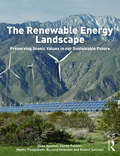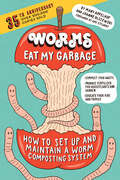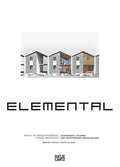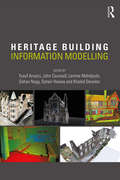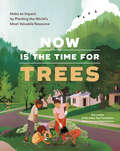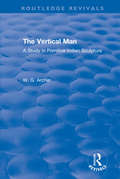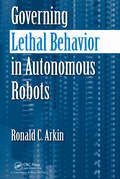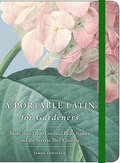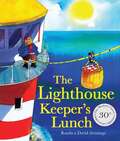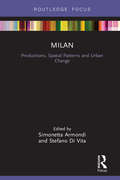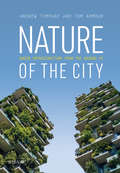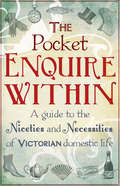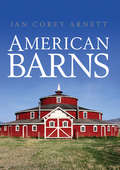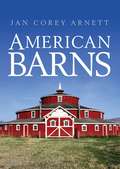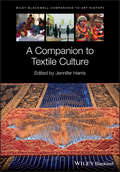- Table View
- List View
The Renewable Energy Landscape: Preserving Scenic Values in our Sustainable Future
by Dean Apostol James Palmer Martin Pasqualetti Richard Smardon Robert SullivanWinner of the 2017 EDRA Great Places Award (Research Category) Winner of the 2017 VT ASLA Chapter Award of Excellence (Communications Category) The Renewable Energy Landscape is a definitive guide to understanding, assessing, avoiding, and minimizing scenic impacts as we transition to a more renewable energy future. It focuses attention, for the first time, on the unique challenges solar, wind, and geothermal energy will create for landscape protection, planning, design, and management. Topics addressed include: Policies aimed at managing scenic impacts from renewable energy development and their social acceptance within North America, Europe and Australia Visual characteristics of energy facilities, including the design and planning techniques for avoiding or mitigating impacts or improving visual fit Methods of assessing visual impacts or energy projects and the best practices for creating and using visual simulations Policy recommendations for political and regulatory bodies. A comprehensive and practical book, The Renewable Energy Landscape is an essential resource for those engaged in planning, designing, or regulating the impacts of these new, critical energy sources, as well as a resource for communities that may be facing the prospect of development in their local landscape.
The Renewable Energy Landscape: Preserving Scenic Values in our Sustainable Future
by Dean Apostol James Palmer Martin Pasqualetti Richard Smardon Robert SullivanWinner of the 2017 EDRA Great Places Award (Research Category) Winner of the 2017 VT ASLA Chapter Award of Excellence (Communications Category) The Renewable Energy Landscape is a definitive guide to understanding, assessing, avoiding, and minimizing scenic impacts as we transition to a more renewable energy future. It focuses attention, for the first time, on the unique challenges solar, wind, and geothermal energy will create for landscape protection, planning, design, and management. Topics addressed include: Policies aimed at managing scenic impacts from renewable energy development and their social acceptance within North America, Europe and Australia Visual characteristics of energy facilities, including the design and planning techniques for avoiding or mitigating impacts or improving visual fit Methods of assessing visual impacts or energy projects and the best practices for creating and using visual simulations Policy recommendations for political and regulatory bodies. A comprehensive and practical book, The Renewable Energy Landscape is an essential resource for those engaged in planning, designing, or regulating the impacts of these new, critical energy sources, as well as a resource for communities that may be facing the prospect of development in their local landscape.
Worms Eat My Garbage, 35th Anniversary Edition: How to Set Up and Maintain a Worm Composting System: Compost Food Waste, Produce Fertilizer for Houseplants and Garden, and Educate Your Kids and Family
by Mary Appelhof Joanne OlszewskiFor more than three decades, this best-selling guide to the practice of vermicomposting has taught people how to use worms to recycle food waste into nutrient-rich fertilizer for houseplants or gardens. Small-scale, self-contained worm bins can be kept indoors, in a basement, or even under the kitchen sink in an apartment — making vermicomposting a great option for city dwellers and anyone who doesn&’t want or can&’t have an outdoor compost pile. The fully revised 35th anniversary edition features the original&’s same friendly tone, with up-to-date information on the entire process, from building or purchasing a bin (readily available at garden supply stores) to maintaining the worms and harvesting the finished compost.
Elemental: Incremental Housing and Participatory Design Manual
by Alejandro Aravena Andrés IacobelliWhat began as an academic initiative to improve the quality of life of the poor strata of the population has now become a professional “do tank” offering services that cover the entire spectrum of urban development. The celebrated Chilean architect, winner of the 2016 Pritzker Prize and Director of the 2016 Venice Architecture Biennale, Alejandro Aravena (born 1967) founded Elemental in 2001 in his hometown with the goal of alleviating social deprivation directly instead of hoping for a balance of income relations. Besides building public facilities and public housing, Elemental also develops new approaches for the reorganization of resources and the potential of cities by means of projects devoted to infrastructure and transportation. This volume, first published in 2013 and now back in print, documents the social activity and history of the international architectural team and sheds light on its financing strategies, for example through participatory building.
Elemental
by Alejandro Aravena Andrés IacobelliWhat began as an academic initiative to improve the quality of life of poor strata of the population has meanwhile become a professional “do tank” offering services that cover the entire spectrum of urban development. Alejandro Aravena (*1967 in Santiago de Chile) founded Elemental in 2001 in his hometown with the goal of alleviating social deprivation directly instead of hoping for a balance of income relations. Besides building public facilities and public housing, Elemental also develops new approaches for the reorganization of resources and the potential of cities by means of projects devoted to infrastructure and transportation. This publication documents the social activity and history of the international architectural team and sheds light on its financing strategies, for example through participative building. 15th International Architecture Exhibition, Venice, May 28–November 27, 2016
Heritage Building Information Modelling
by Yusuf Arayici John Counsell Lamine Mahdjoubi Gehan Ahmed Nagy Soheir Hawas Khaled DweidarBuilding Information Modelling (BIM) is being debated, tested and implemented wherever you look across the built environment sector. This book is about Heritage Building Information Modelling (HBIM), which necessarily differs from the commonplace applications of BIM to new construction. Where BIM is being used, the focus is still very much on design and construction. However, its use as an operational and management tool for existing buildings, particularly heritage buildings, is lagging behind. The first of its kind, this book aims to clearly define the scope for HBIM and present cutting-edge research findings alongside international case studies, before outlining challenges for the future of HBIM research and practice. After an extensive introduction to HBIM, the core themes of the book are arranged into four parts: Restoration philosophies in practice Data capture and visualisation for maintenance and repair Building performance Stakeholder engagement This book will be a key reference for built environment practitioners, researchers, academics and students engaged in BIM, HBIM, building energy modelling, building surveying, facilities management and heritage conservation more widely.
Heritage Building Information Modelling
by Yusuf Arayici John Counsell Lamine Mahdjoubi Gehan Ahmed Nagy Soheir Hawas Khaled DweidarBuilding Information Modelling (BIM) is being debated, tested and implemented wherever you look across the built environment sector. This book is about Heritage Building Information Modelling (HBIM), which necessarily differs from the commonplace applications of BIM to new construction. Where BIM is being used, the focus is still very much on design and construction. However, its use as an operational and management tool for existing buildings, particularly heritage buildings, is lagging behind. The first of its kind, this book aims to clearly define the scope for HBIM and present cutting-edge research findings alongside international case studies, before outlining challenges for the future of HBIM research and practice. After an extensive introduction to HBIM, the core themes of the book are arranged into four parts: Restoration philosophies in practice Data capture and visualisation for maintenance and repair Building performance Stakeholder engagement This book will be a key reference for built environment practitioners, researchers, academics and students engaged in BIM, HBIM, building energy modelling, building surveying, facilities management and heritage conservation more widely.
Now Is the Time for Trees: Make an Impact by Planting the Earth's Most Valuable Resource
by Arbor Day Foundation Dan Lambe&“Celebrates the power of trees to oxygenate the planet, purify water and air, lower city temperatures, provide habitat, nurture the soul, and provide essential food sources.&” —Booklist Trees and forests are the number one nature-based solution for reversing the negative effects of a changing climate. If ever there was a time to be planting trees, that time is now. Inspired by a collective sense of urgency, a global movement to plant trees is gaining momentum. To move the needle, we need to act on a massive scale and plant millions of trees today to have a measurable and lasting impact on billions of lives tomorrow. In Now Is the Time for Trees, the experts at the Arbor Day Foundation will inspire you to do your part by showing you everything you need to know to plant trees at home or in your community. From advice on choosing the right size and type of tree to tried-and-true tips for planting success, this book will help you plant a tree today and leave your own legacy of hope. Equal parts inspiration and advocacy, Now Is the Time for Trees is a rousing call for environmental action and a must-have book for nature lovers everywhere.
The Vertical Man: A Study in Primitive Indian Sculpture (Routledge Revivals)
by W.G. ArcherOriginally published in 1947, The Vertical Man explores a form of Indian sculpture largely ignored in other studies, with a focus on two kinds of sculpture from the province of Bihar. The book provides detailed analysis of the formal characteristics of the sculpture and the influences of the myth, ritual, and context in which they were commissioned and made. It explains why the sculpture is regional and "why the styles are what they are". It is an original study which throws light on important subjects such as the relations of art and religion and of art and economics. The Vertical Man will appeal to those with an interest in art, specifically sculpture and the art of the Indian countryside.
The Vertical Man: A Study in Primitive Indian Sculpture (Routledge Revivals)
by W.G. ArcherOriginally published in 1947, The Vertical Man explores a form of Indian sculpture largely ignored in other studies, with a focus on two kinds of sculpture from the province of Bihar. The book provides detailed analysis of the formal characteristics of the sculpture and the influences of the myth, ritual, and context in which they were commissioned and made. It explains why the sculpture is regional and "why the styles are what they are". It is an original study which throws light on important subjects such as the relations of art and religion and of art and economics. The Vertical Man will appeal to those with an interest in art, specifically sculpture and the art of the Indian countryside.
Envisioning Better Communities: Seeing More Options, Making Wiser Choices
by Randall ArendtThe author's work has shaped a generation of planners, designers, and landscape architects. In this book, the author brings his insights to a broader public, with a profusely illustrated demonstration of how local officials, planning commissioners, and everyday citizens can work to make their communities more attractive, more habitable, and more sustainable. Despite the widespread acceptance of good design and planning principles throughout the professions, too many of our towns and rural areas remain needlessly ugly and inefficient. In side by side comparisons of similar places and kinds of buildings, the author shows that we need not live amid sprawling, characterless visual blight. Simple design choices and effective municipal decisions can have tremendous impacts on the quality of our communities. Written in the author's well-known clear, accessible, nontechnical style, this book creates a sense of hope for those who face the everyday challenges of working with developers and landowners to create places that make economic, environmental, and aesthetic sense. The author shows us that with diligence, thoughtfulness, and care, we can make our communities better in countless ways.
Envisioning Better Communities: Seeing More Options, Making Wiser Choices
by Randall ArendtThe author's work has shaped a generation of planners, designers, and landscape architects. In this book, the author brings his insights to a broader public, with a profusely illustrated demonstration of how local officials, planning commissioners, and everyday citizens can work to make their communities more attractive, more habitable, and more sustainable. Despite the widespread acceptance of good design and planning principles throughout the professions, too many of our towns and rural areas remain needlessly ugly and inefficient. In side by side comparisons of similar places and kinds of buildings, the author shows that we need not live amid sprawling, characterless visual blight. Simple design choices and effective municipal decisions can have tremendous impacts on the quality of our communities. Written in the author's well-known clear, accessible, nontechnical style, this book creates a sense of hope for those who face the everyday challenges of working with developers and landowners to create places that make economic, environmental, and aesthetic sense. The author shows us that with diligence, thoughtfulness, and care, we can make our communities better in countless ways.
Governing Lethal Behavior in Autonomous Robots
by Ronald ArkinExpounding on the results of the author's work with the US Army Research Office, DARPA, the Office of Naval Research, and various defense industry contractors, Governing Lethal Behavior in Autonomous Robots explores how to produce an "artificial conscience" in a new class of robots, humane-oids, which are robots that can potentially perform more et
A Portable Latin for Gardeners: More than 1,500 Essential Plant Names and the Secrets They Contain
by James ArmitageHaving an understanding of botanical Latin unlocks an entirely new layer of the plant world. Gardeners deciding between a Crocus flavus and Crocus graveolens will know that one produces deep yellow flowers while the other boasts a prominent smell. They can tell whether a plant should have one (unifolius), two (diphyllus), or even nine leaves (enneaphyllus). And they can catch the nods to Sir Joseph Banks in Cordyline banksia and Queen Victoria in Agave victoriae-reginae. A Portable Latin for Gardeners is the perfect quick reference for working in the garden, shopping for plants, or doing botanical research—and no prior knowledge of Latin is required. The 1,500 terms are grouped by categories, making it easy to describe color, size, form, habitat, scent, taste, and time. Gardeners will make new connections and discoveries in a way standard alphabetical lists simply don’t allow. Alternately, gardeners who want to look up a particular term can jump right into the alphabetical index. Each entry includes the different forms of the term, a basic pronunciation guide, the definition, and an example plant species. Rich botanical illustrations make this guide as beautiful as it is useful, while a durable flexi-bound cover means the book can withstand both days in the garden and evenings on the nightstand.
A Portable Latin for Gardeners: More than 1,500 Essential Plant Names and the Secrets They Contain
by James ArmitageHaving an understanding of botanical Latin unlocks an entirely new layer of the plant world. Gardeners deciding between a Crocus flavus and Crocus graveolens will know that one produces deep yellow flowers while the other boasts a prominent smell. They can tell whether a plant should have one (unifolius), two (diphyllus), or even nine leaves (enneaphyllus). And they can catch the nods to Sir Joseph Banks in Cordyline banksia and Queen Victoria in Agave victoriae-reginae. A Portable Latin for Gardeners is the perfect quick reference for working in the garden, shopping for plants, or doing botanical research—and no prior knowledge of Latin is required. The 1,500 terms are grouped by categories, making it easy to describe color, size, form, habitat, scent, taste, and time. Gardeners will make new connections and discoveries in a way standard alphabetical lists simply don’t allow. Alternately, gardeners who want to look up a particular term can jump right into the alphabetical index. Each entry includes the different forms of the term, a basic pronunciation guide, the definition, and an example plant species. Rich botanical illustrations make this guide as beautiful as it is useful, while a durable flexi-bound cover means the book can withstand both days in the garden and evenings on the nightstand.
The Lighthouse Keeper's Lunch (The\lighthouse Keeper Ser.)
by Ronda Armitage David ArmitageAvailable for the first time as an ebook, THE LIGHTHOUSE KEEPER'S LUNCH is a modern classic, loved by children everywhere. Every day the lighthouse keeper tucks into a delicious lunch. But he isn't the only one who enjoys the tasty food. What will stop the greedy gulls from stealing the lighthouse keeper's lunch?
Milan: Productions, Spatial Patterns and Urban Change (Built Environment City Studies)
by Simonetta Armondi Stefano Di VitaAs a main urban centre of one of the most dynamic European regions, Milan is a key location from which to study narratives of innovations and contemporary productions – old and new manufacturing, tertiary and consumptive sectors, creative and cultural economy – and investigate their influence both on spatial patterns and urban policy agenda. Accordingly, this book explores the contentious geographies of innovation, productions and working spaces, both empirically and theoretically in a city that, since the beginning of the 2000s, has been involved in a process of urban change, with relevant spatial and socio-economic effects, within an increasingly turbulent world economy. Through this analysis, the book provides an insight into the complexity of contemporary urban phenomena beyond a traditional metropolitan lens, highlighting issues such as rescaling, urban decentralization and recentralization, extensive urban transformation and shrinkage and molecular urban regeneration. This book is a valuable resource for academics, researchers and scholars focusing on Urban Studies such as Urban Policy, Urban Planning, Urban Geography, Urban Economy and Urban Sociology.
Milan: Productions, Spatial Patterns and Urban Change (Built Environment City Studies)
by Simonetta Armondi Stefano Di VitaAs a main urban centre of one of the most dynamic European regions, Milan is a key location from which to study narratives of innovations and contemporary productions – old and new manufacturing, tertiary and consumptive sectors, creative and cultural economy – and investigate their influence both on spatial patterns and urban policy agenda. Accordingly, this book explores the contentious geographies of innovation, productions and working spaces, both empirically and theoretically in a city that, since the beginning of the 2000s, has been involved in a process of urban change, with relevant spatial and socio-economic effects, within an increasingly turbulent world economy. Through this analysis, the book provides an insight into the complexity of contemporary urban phenomena beyond a traditional metropolitan lens, highlighting issues such as rescaling, urban decentralization and recentralization, extensive urban transformation and shrinkage and molecular urban regeneration. This book is a valuable resource for academics, researchers and scholars focusing on Urban Studies such as Urban Policy, Urban Planning, Urban Geography, Urban Economy and Urban Sociology.
Nature of the City: Green Infrastructure from the Ground Up
by Tom Armour Andrew TempanyThis is a practical guide to delivering green infrastructure from the ground up and bringing nature in to the built environment. Exploring the process of delivery through an array of design approaches and case studies, it demystifies the concept and provides the tools for practical implementation - highlighting the challenges and opportunities on both small and large projects.
Nature of the City: Green Infrastructure from the Ground Up
by Tom Armour Andrew TempanyThis is a practical guide to delivering green infrastructure from the ground up and bringing nature in to the built environment. Exploring the process of delivery through an array of design approaches and case studies, it demystifies the concept and provides the tools for practical implementation - highlighting the challenges and opportunities on both small and large projects.
The Pocket Enquire Within: A guide to the niceties and necessities of Victorian domestic life
by George ArmstrongWhat is the correct way to carve a partridge?How should leeches be applied?How can egg whites be used to repair broken china?First published in 1856, Enquire Within rapidly became the indispensable guide to Victorian domestic life. Packed with words of wisdom and pithy advice, it covered everything from entertaining and etiquette to household management, and took in considered discussion of such arcane matters as how singing might prevent consumption, and which ointments will remove freckles, not to mention why chess should on no account ever be played at a ball.This new, charmingly illustrated pocket-sized edition contains a selection of hints and tips that not only provide a fascinating insight into the day-to-day life of Victorian Britain, but also, in places, reveal timeless wisdom that we would do well to heed today.
American Barns (Shire Library Usa Ser. #751)
by Jan Corey ArnettThe heart of every working farm and ranch, the barn is an icon of rural America. This book chronicles – and celebrates – all the main types, and looks at how these treasures of early American architecture developed. It explains how a wealth of immigrant construction methods and range of environments and climates resulted in a fascinating variety of barn styles in the United States, from the earliest rare Dutch examples to simpler English types and others in more surprising shapes (round or even polygonal) crafted by the Shakers in the 1800s. It highlights the most notable, famous and historic barns that the reader can visit, and features the efforts of conservation groups to preserve America's barns and find innovative ways to repurpose these glorious old structures as homes and studios – and as living monuments of rural heritage.
American Barns (Shire Library USA #751)
by Jan Corey ArnettThe heart of every working farm and ranch, the barn is an icon of rural America. This book chronicles – and celebrates – all the main types, and looks at how these treasures of early American architecture developed. It explains how a wealth of immigrant construction methods and range of environments and climates resulted in a fascinating variety of barn styles in the United States, from the earliest rare Dutch examples to simpler English types and others in more surprising shapes (round or even polygonal) crafted by the Shakers in the 1800s. It highlights the most notable, famous and historic barns that the reader can visit, and features the efforts of conservation groups to preserve America's barns and find innovative ways to repurpose these glorious old structures as homes and studios – and as living monuments of rural heritage.
A Companion to Textile Culture (Blackwell Companions to Art History)
by Dana ArnoldA lively and innovative collection of new and recent writings on the cultural contexts of textiles The study of textile culture is a dynamic field of scholarship which spans disciplines and crosses traditional academic boundaries. A Companion to Textile Culture is an expertly curated compendium of new scholarship on both the historical and contemporary cultural dimensions of textiles, bringing together the work of an interdisciplinary team of recognized experts in the field. The Companion provides an expansive examination of textiles within the broader area of visual and material culture, and addresses key issues central to the contemporary study of the subject. A wide range of methodological and theoretical approaches to the subject are explored—technological, anthropological, philosophical, and psychoanalytical, amongst others—and developments that have influenced academic writing about textiles over the past decade are discussed in detail. Uniquely, the text embraces archaeological textiles from the first millennium AD as well as contemporary art and performance work that is still ongoing. This authoritative volume: Offers a balanced presentation of writings from academics, artists, and curators Presents writings from disciplines including histories of art and design, world history, anthropology, archaeology, and literary studies Covers an exceptionally broad chronological and geographical range Provides diverse global, transnational, and narrative perspectives Included numerous images throughout the text to illustrate key concepts A Companion to Textile Culture is an essential resource for undergraduate and postgraduate students, instructors, and researchers of textile history, contemporary textiles, art and design, visual and material culture, textile crafts, and museology.
A Companion to Textile Culture (Blackwell Companions to Art History)
by Dana ArnoldA lively and innovative collection of new and recent writings on the cultural contexts of textiles The study of textile culture is a dynamic field of scholarship which spans disciplines and crosses traditional academic boundaries. A Companion to Textile Culture is an expertly curated compendium of new scholarship on both the historical and contemporary cultural dimensions of textiles, bringing together the work of an interdisciplinary team of recognized experts in the field. The Companion provides an expansive examination of textiles within the broader area of visual and material culture, and addresses key issues central to the contemporary study of the subject. A wide range of methodological and theoretical approaches to the subject are explored—technological, anthropological, philosophical, and psychoanalytical, amongst others—and developments that have influenced academic writing about textiles over the past decade are discussed in detail. Uniquely, the text embraces archaeological textiles from the first millennium AD as well as contemporary art and performance work that is still ongoing. This authoritative volume: Offers a balanced presentation of writings from academics, artists, and curators Presents writings from disciplines including histories of art and design, world history, anthropology, archaeology, and literary studies Covers an exceptionally broad chronological and geographical range Provides diverse global, transnational, and narrative perspectives Included numerous images throughout the text to illustrate key concepts A Companion to Textile Culture is an essential resource for undergraduate and postgraduate students, instructors, and researchers of textile history, contemporary textiles, art and design, visual and material culture, textile crafts, and museology.
